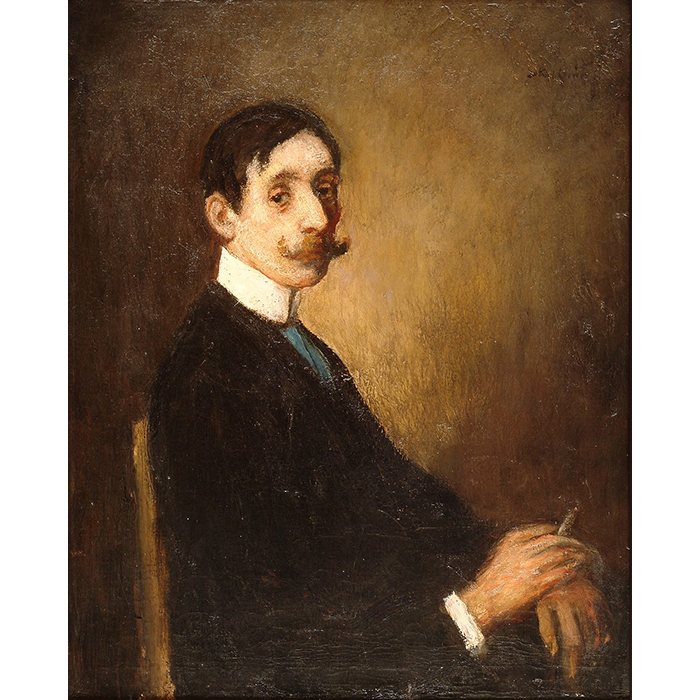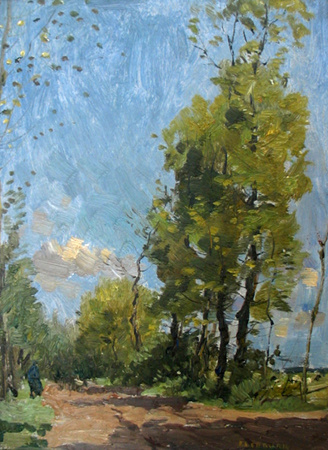Frederick Simpson Coburn
F.S. Coburn (1871-1960 - Artist Biography
Born at Upper Melbourne, Quebec, he frequently sketched horses as a boy. In later years Dr. William Henry Drummond, aware of the boy’s talent was instrumental in having him sent to Notman and Sandham in Montreal for advice about his gift. Coburn was guided to the Arts and Crafts School in Montreal where he studied under C. S. Stevenson. In the following years he attended class under Carl Hecker in New York; Erhentraut Skarbina at the Academy of Berlin; classes in Munich; at the Ecole des Beaux Arts under Jean Léon Gérôme; under Henry Tonks in London at the Slade School; under Abrecht de Vrient in Antwerp.
In Antwerp he married Malvina Schiepers, a painter in her own right, and they had a studio in that city for about 20 years, returning to Canada on visits. About 1898 Coburn met Dr. Drummond again, who was by then gaining fame for his poems. Dr. Drummond recommended Coburn to the G. P. Putnam Publishing Company in New York, to illustrate his poems of habitant life. This led him into the career of a successful illustrator, and also paid for his studies abroad. Coburn was almost swamped with commissions in this field. While studying under Tonks in London he did paintings for the London Sporting and Dramatic News, and illustrations for the London News. He had a deep interest in the “Luminous rolling skies” of J. H. Weissenbrunch and the plowmen and horses of James Maris which showed up in his own work a few years later. Colburn’s illustrations for Drummond’s poems were done with black and white oil paintings, still owned by the Drummond family in Montreal.
About 1914 he turned to oils in colour through the encouragement of Maurice Cullen and a little later on decided to specialize in the painting of horse and oxen drawn sleds in Laurentian and Eastern Townships settings. His very first painting on this theme was kept by him during his lifetime. Those that followed however were bought by eager collectors mainly through The Stevens Art Gallery, in Montreal. Gerald Stevens tells us in his book, “In the years to come Mr. Coburn was to hire many a farmer and his team to pose for studies and sketches made in oils, or with crayons with which, in a few strokes, he could catch the essential line and and rhythm of a composition later to be transferred to a canvas.” William Colgate in his Canadian Art described his output of sleigh scenes as follows, “The subject may be, and sometimes is, repeated, but the light which illumines it rarely is.”
Coburn also during his career painted a few nudes, still lives, portraits, figure studies and some summer landscapes. He did not, however, receive official recognition until 1920, when he became an associate of the Royal Canadian Academy. Seven years later, he was made full member. Coburn’s pictures were so much in demand that he never had any on hand for a solo show. His other media included watercolours, a few engravings on wood, and etchings. He was also a photographer of note. He was a member of the Pen and Pencil Club of Montreal (Pres. 1942-2). In 1936 he received an Honorary Doctor of Civil Law conferred upon him by Bishop’s University at Lennoxville, Quebec.
He is represented in the collections of the National Gallery, Brisbane, Australia; The Tate Gallery, London, England; in the National Gallery of Canada by two of his canvases of horse drawn sleighs in Quebec winter settings; in galleries in Japan; Belgium; Europe; and the USA.
Opposite: Coburn in 1896 (portrait by Jakob Smits)
Bio c/o: A Dictionary of Canadian Artists, Volume I: A-F, compiled by Colin S. MacDonald, Canadian Paperbacks Publishing Ltd, Ottawa, 1977
Artist Specialization: Frederick Simpson Coburn's paintings of horses hauling logs through snowy woodlands, and bright red sleighs down sunny country roads captured the spirit of an era and his winter scenes appeared regularly on Christmas cards throughout the early twentieth century. The term 'Coburn sky' originated from the artist's unique treatment of luminous winter cloud effects. During the the early 1900s, Coburn began to integrate the advanced techniques he had learned from the Europeans with his own vision. At first he focused on floral studies, portraits, and spring and summer landscapes of the Eastern Townships. In these canvases the Dutch influence was obvious. Then, sketching trips with fellow artist, mentor and close friend, Maurice Cullen, brought about a sudden change. Inspired and challenged by Cullen's fascination with the Canadian winter, Coburn rejected his sombre, Old-World palette to experiment with vivid colours.


